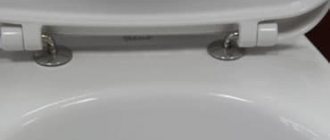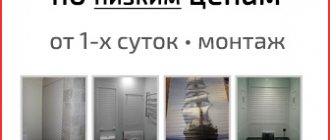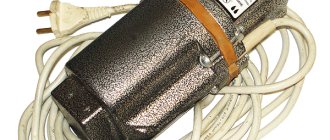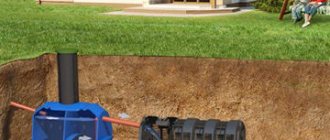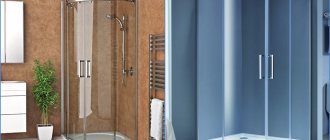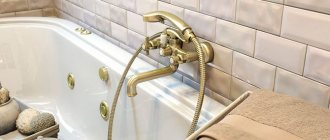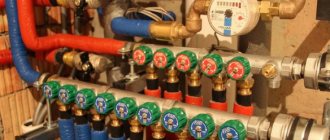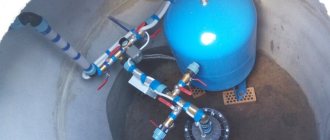The topic of choosing a toilet is much more extensive than it might seem. To ensure that the toilet does not splash, flushes well and does not make noise, before purchasing it you need to thoroughly understand the characteristics so as not to become a victim of sales consultants. We have collected the main features that you should rely on, and are ready to briefly talk about them without unnecessary epithets. And at the end we have prepared a bonus: a list of the most popular models.
Navigation:
- Manufacturing materials
- Types of toilets by installation and design
- Types of sewer release
- Bowl shape
- Flush types
- Water supply
- Options and features
- Life hacks when purchasing
- Plumber's opinion
- Popular brands and models
Toilet material
Modern technologies make it possible to make anything from anything. So toilet bowls can be made not only from “ceramics”, but also from plastic, cast iron, steel, artificial stone and even marble. Let’s be honest: this is not at all what you are looking for for your home, and therefore we will tell you about the two main and most popular materials for production.
Sanitary Ware
“What kind of sanitaryware?” - you ask. In fact, the prefix “san” means sanitary. Sanitaryware is cheap and widespread, but has a number of disadvantages. Its coating is not so durable, and with its abrasion the amount of dirt and odors increases. But it all depends on the frequency and aggressiveness of use, so for an inexpensive toilet repair for the average family, sanitaryware is quite suitable. Think about it: if some manufacturers estimate a service life of up to 40 years, then that’s not bad at all, right?
Sanitary porcelain
Sanitary porcelain on average costs more (but not always!) and is better able to withstand the various tests that come with it. Water and dirt are repelled better, and these properties last much longer. If we talk about the right choice in general, then do it simply: if you are satisfied with the price and connection parameters of the toilet, buy it, regardless of the material of manufacture.
Types of toilets by installation and design
Floor-standing
These toilets are the most common due to their affordable prices, ease of installation, and simply because the design has been tested by millions of people. The floor-standing toilet is easy to install using the included anchors and bolts. They are also called compact toilets precisely because of their “all-in-one” design. This type has no obvious disadvantages, except that from the point of view of aesthetics it is somewhat outdated. However, all this is a matter of taste.
Hanging
Wall-hung toilets are a more advanced type of plumbing. The bowl is attached to the installation (this is a special metal frame), while the tank is hidden behind the wall - it is simply not visible.
Wall-hung toilets tend to be more expensive and also require additional time and money to install. The biggest fear of buyers is the reliability of the design. In practice, wall-hung toilets, when installed correctly, do not create problems and can easily cope with all loads.
Among the advantages of wall-hung models are a more attractive appearance and free space under the bowl, which makes cleaning much easier. Among the unobvious advantages, we note the ability to adjust the height of the bowl to suit you.
Attached toilets
Wall-mounted toilets require installation close to the wall. Their design is thought out in such a way that there are no gaps as such between the wall and the toilet. Modern and nice solution. However, you will have to think about where to hide the tank. Although there are also combined models.
Corner
Corner toilets are most often a variation of conventional floor-standing models, with the only difference being that the tank has a triangular shape. With it, the toilet sits close to the corner. Some people like it, some don’t, but for the most part, corner models are not particularly popular.
Monoblocks
A type of toilet in which the tank and bowl are a single unit and cannot be disassembled. Monoblocks are not particularly popular, but they still have their fans.
Malfunctions and repairs
More often the filling of the drain tank breaks. Most problems can be fixed on your own.
Water continues to flow after releasing the drain button
To determine the source of the problem, you will need to remove the cover from the device and observe the operation of the system.
- Wait until the tank is filled with water.
- If the liquid continues to decrease during filling, this indicates that the damper is not operating correctly.
- Check the shut-off valve for tightness, integrity and absence of signs of corrosion or limescale deposits.
If deposits are found, it is enough to clean them with a suitable product. In case of depressurization, sanitary silicone is used - for this, the tank will have to be emptied and dried. If the valve is bent or the hole is widened due to hard water, the valve ring will need to be replaced.
Tank leak
This problem is evidenced by the influx of water from places not intended by the design. There may be several reasons:
- Wear of the rubber gasket between the tank and the toilet occurs more often due to the instability of the tank and the weakness of the fasteners. There are wear options due to poor-quality old rubber, limescale or mechanical damage. The verdict in all these cases is the same - the gasket must be replaced. You can purchase an analogue at any plumbing store. Installation will require twisting the tank and sealing the connections.
- The washers of the bolts that secure the tank to the device were worn out - the tank will need to be dismantled. Further inspection of the washers will tell you whether they need to be completely replaced or whether the sealant needs to be updated. It is important not to overtighten the bolts during installation.
- Incorrect operation of the float - due to hard water, the bottom of the float becomes covered with limescale. Its falling off during the flushing process can deform the float or cause uncontrolled overflow. If the integrity of the device is beyond doubt, there are no signs of deformation, it is enough to clean the bottom of deposits. In other cases, you will have to change the float, and in rare models, the entire drain mechanism.
- Crack in tank - Buy a porcelain repair kit or make your own by grinding a small piece of porcelain into powder and mixing with epoxy glue. At the time of repair, the tank must be emptied and dried. Fix the crack by applying the mixture with a putty knife. Leave it for a day to dry and then carefully fill the tank with water. If the leak is fixed, it will last for several more years with a patch. In difficult cases, the tank must be replaced.
Difficulty flushing
The problem is due to the low water level in the tank or the valve flap closing too quickly.
- Lift the reservoir cap to check the water level. It is set by a float - a rubber or plastic ball floating on the surface. If the level is low, adjust it manually to fill the tank to the desired volume.
- If there is a problem with the valve, check the length of the chain attached to it. Adjust the tension without over-tightening the chain.
Water does not drain
The sewer pipe is clogged.
Cleaning methods:
- A tool for removing blockages - will help in mild cases or when clogged with household waste and grease.
- Plunger - creates a vacuum that pushes individual particles of clog to the surface.
- Mechanical cleaning - in difficult cases. Depending on the depth of the problem area, you will need a long knitting needle, a piece of flexible hose or a special cable. To be effective, pulling and pushing is combined with filling the hole with degreasers.
If none of the solutions work, call a plumber.
The button doesn't work
Traction is damaged. You will need to remove the cover, disconnect the button and check the nature of the damage. If the part is metal, in most cases it will be deformed, but intact. It is straightened using improvised means, after which the push-button system is assembled in the reverse order.
In the case of plastic button fittings, we can talk about tearing or breaking off the legs of the part. Will need replacement. As a temporary solution, the broken rod is replaced with a piece of thick wire or a long thin sliver.
To troubleshoot the drain system, the shut-off valve is closed and the mechanism is disconnected from the water supply network to avoid spills.
Discharge and connection to sewerage
This is one of the main parameters that buyers pay attention to. To choose the right toilet, you should study the location of its installation in advance: where is the sewer pipe located?
Horizontal release
In such toilets the outlet is made parallel to the floor. A simple and understandable solution, as long as the sewerage supply allows for connection. The horizontal release is completely interchangeable with the oblique release - more on that later.
Oblique release
In fact, this is the same horizontal outlet, but raised above the floor at an angle. The drain angle is usually 30 or 45 degrees. An oblique outlet should be selected when the entry into the sewer is made at an angle. Then the “highway” of release will be straight.
Vertical release
Toilets with vertical outlet are designed for cases where sewer pipes are located under the floor. This is extremely rare in the CIS. But if you're building your own home from scratch, just be aware of this possibility.
Universal edition
People love universal solutions, so it is not surprising that a universal version was invented for toilets. In catalogs it may also be called a "vario" release. To connect, you must specifically select a pipe that will exit horizontally or at an angle. The solution is interesting, but, like many universal things, it may seem unnecessarily complicated or inconvenient. If everything is clear with your sewerage system, choose models with familiar types of outlets.
Standard toilet sizes and minimum toilet size
GOST 30493-96 standardizes the dimensions of toilets with a shelf only. There are also those that are installed in cars, but we don’t need them. The standard dimensions of a toilet with a shelf are prescribed for two options: with a solid cast and with an attached one. The second model is used in conjunction with mounted/wall-mounted tanks or without them at all. There are also standard sizes for children's toilets. They (children's) come without a shelf. All sizes are shown in the table. To understand what we are talking about, let’s look at the drawings.
Drawing of a toilet with a solid cast shelf and an oblique outlet from GOST
| Toilet design | H | h | h1 | l | l1 | L (depth or length) | b | B (width at widest point) |
| With a one-piece shelf for installing a tank (Compact) | 150 | 330 | 435 | no less than 605 (maybe 575 mm) | 260 | 340 and 360 | ||
| Without shelf (mounted tank) | 370 and 400 | 320 and 350 | 460 | |||||
| Children's | 335 | 285 | 130 | 280 | 380 | 405 | 210 | 290 |
So, the standard size of a toilet with a shelf (usually called “Compact”):
- Length - L - 605 mm. This is taking into account the fact that the model is compact with a protrusion for installing a tank. It is separately stated that shorter models with a length of up to 575 mm can be produced.
- Width - B - also two standard values: 340 and 360 mm.
The height of toilets is not standardized, but usually within the range of 370-390 mm. So, according to the standard, the narrowest toilet is 340 mm, and the shortest model “compact with shelf and oblique flush” is 575 mm. Based on these values and the minimum permissible distances from the previous paragraph, we can determine the minimum dimensions of the toilet for installing such a model. Let's start by calculating the width: 340 mm + 2 * 250 mm = 840 mm. That is, the distance between the walls cannot be less than 84 cm. Better, of course, more.
And the length of the toilet should be 575 mm + 600 mm = 1175 mm. But this does not take into account the fact that it is also necessary to lay a sewer pipe and somehow connect the drain. We will allocate another 20 cm for this. In total, we find that the minimum length of the toilet room is 1175 mm + 200 mm = 1375 mm. In meters it is 1.375 m.
Standard dimensions of a toilet without a shelf (with a hanging cistern) from GOST
The standard dimensions of a toilet with a wall-mounted cistern are significantly smaller: length/depth 460 mm, width 360 mm and 340 mm. That is, the room may be shorter. Its minimum depth is 1060 mm - this is only for a comfortable installation of the bowl, but you still need to connect the pipes, so we’ll add another 20 cm. In total, we get that to install a toilet with a wall-mounted cistern, the room must be at least 126 * 84 cm. A if you have a longer room, you can move the miracle of plumbing back, and make a cabinet with shelves behind the toilet and/or above it.
Bowl shape
Let’s make a reservation right away: regardless of the shape of the bowl, the toilet will cope with the functions assigned to it. Another thing is the appearance of some features in operation.
Funnel-shaped
The drain hole in such bowls is located almost strictly in the center, and the angle of inclination to it is the same on all sides. They say that with such a bowl you have to use a brush less often, and flushing happens quickly and efficiently.
But there is also a minus - splashes. Manufacturers are trying to get rid of this drawback in various ways, but if when choosing a toilet it is important for you that it does not splash, pay attention to other bowl shapes.
Disc-shaped
It is the disc-shaped bowl that ensures that there is no splashing when flushing. But at the same time it has other disadvantages. Thus, waste first falls on a special shelf, and only from there, with the help of water, is sent to the drain. Dish-shaped bowls do a poor job of hiding odors and require more frequent cleaning with a brush. In addition, due to the constant accumulation of water on the shelf, plaque may appear there over time. Nowadays it is difficult to find plate-shaped bowls - they are frankly outdated.
Kozyrkovaya
The visor bowl resembles a funnel, but its walls are not at the same angle. Such a toilet will not create splashes when flushed and further spread unpleasant odors. The walls of the bowl will have to be cleaned, but not as often and as vigorously as it could be. Overall, the visor bowl is one of the best options to choose from.
Flush type
There are two types of flushing
- straight
- circular
Straight is sometimes called cascading or horizontal. The water simply “runs” in a straight line from the tank, and most of the bowl is not washed. The circular type solves this drawback and is found in most modern models.
Water supply
The tank is also not as simple as it seems. Modern toilet cisterns have bottom, side and rear water supplies. What is the difference and which is better?
With a bottom water supply, the hoses are connected directly to the “bottom” of the tank. This not only looks neater, but also provides a quieter water supply. The bottom supply is considered almost the standard for a good toilet.
The rear and side inlets are located at the top of the tank and differ only in ease of installation and location of the entrance, as the name suggests. The rear connection can be completely hidden in the wall; with the side connection, the trick is unlikely to be possible. And any of these types will be noisier than the lower one. It's not a big deal and the noise of the waterfall is still a long way off, but just be aware.
By the way, the same toilet models can be produced with different types of outlet, and some immediately have universal solutions.
How to use
The first step after installing any type of plumbing fixture is to prevent water from getting into unintended areas. All joints with surfaces must be treated with sanitary silicone sealant. It will need to be updated from time to time.
How to understand that the sealant needs to be replaced:
- The silicone layer has turned yellow or gray - renovation for aesthetic purposes.
- The sealant looks normal, but allows water to pass through - complete removal is unnecessary, a spot update is enough.
- The silicone is covered with a black coating - there are problems with ventilation in the room. Plaque is a fungus. If you do not plan to change the hood and install an additional fan, the sealant will have to be renewed every six months.
Further maintenance of the toilet boils down to its hygienic cleaning.
Regardless of the type of device and the material from which it is made, it is unacceptable to clean the equipment with sharp metal objects.
- Glazed surfaces are cleaned with any available means, including solvents and alkalis. The surface will not be damaged.
- Acrylic models cannot be cleaned with chemical solvents.
- The resulting plaque is removed with special means. Household mixtures are also used - soda with lemon juice, water and vinegar in equal proportions.
- Upon completion of washing and cleaning, wipe the device with a dry, soft, lint-free cloth.
Equipment should be protected from falls and impacts. All models, except those made of stainless steel, can be broken. The stainless steel version will not crack, but may become deformed.
Features and additional options
A toilet has long been not just a “potty” for natural needs, but a completely full-fledged product, which may have more options than another inexpensive car. Let's briefly look at the most common ones in the mini-directory.
Anti-splash. In fact, this is not an option, but rather a set of solutions that will allow you to make “gurgle” without excess water. Not all manufacturers note this feature, but this does not mean that there will be a lot of splashes from the toilet.
Antibacterial coating. According to manufacturers, special coating of the toilet bowl and/or seat will not allow bacteria to grow and multiply. Hygiene is everything.
Rimless toilets. Fundamentally no different from ordinary ones. The bowl simply does not have a rim from under which water flows during flushing. The rim is a difficult area to clean, and its absence will help keep the toilet clean.
Partial drain. It is also called half-mode as well as dual-mode. It is not always necessary to empty the entire tank, and that is why some models can empty only a certain part of it. Also in the characteristics you can find descriptions such as one-, two- or three-mode drainage. Everything is simple with them. Single-mode - drains all the water at once. Dual-mode – can work with half volumes. Three-mode - allows you to stop the drain at the right time. In any case, the function will be useful because it allows you to save water.
Hygienic shower. Using water instead of toilet paper is considered more hygienic. In practice, this means either the presence of a “fountain” in the toilet design, or the presence of a watering can with a hose. Toilets with showers are more expensive than regular ones and more difficult to install. Installing a separate watering can is also sometimes easier.
Drying. After using a hygienic shower, excess water must be removed. This can be done with paper, or with special drying. For obvious reasons, there is no option separate from the shower.
Seat microlift or pneumatic cover. An inexpensive option from the category of “nice little things”, like door closers on door facades. With it, the lid will not fall on the tank with a crash, but will softly and smoothly fall on it without unnecessary noise. In addition to quiet operation, the microlift will ensure that there are no impacts on the lid itself, which has a positive effect on its durability.
Heated seat. The name speaks for itself. If it’s really cold in the toilet and your butt is freezing, it can be useful. To connect the toilet seat you will need an outlet. Another interesting feature is that these seats can be purchased separately.
Backlight. A decorative option with a hint of practicality. Whether it is necessary or not is up to you to decide.
Remote Control. Yes, toilets also have remote controls that control all options like heating or shower.
Automatic raising and lowering of the seat. A fashionable option that will allow you not to touch the seat with your hands. On the one hand, it provides additional hygiene, on the other hand, you still need to wash your hands after visiting the toilet.
Automatic drain. You are probably already familiar with it after visiting public toilets. This function is unlikely to be urgently needed at home, but it is also available just in case.
Colored toilets and models with drawings. They don't happen often, but they do happen. It’s a matter of taste, but you won’t see this in any stylish modern interior. White is the best choice.
Lid and seat
The main requirement for seats with covers is to ensure ease of use of the plumbing fixture and to isolate the room from dirty water. Therefore, the material they are made of should be easy to care for and clean, have high thermal insulation properties, or rather low thermal conductivity.
These requirements are best met by the following materials for the manufacture of toilet seat covers:
Plastic
Polyvinyl chloride (PVC) in comparison with other thermoplastics (polypropylene, low- or high-density polyethylene, polyurethane and others) has a number of attractive physical and chemical characteristics. Thermal conductivity, which is lower for PVC than for similar polymers, plays a decisive role when used as toilet seats. An important role is played by the flexibility, strength and ductility of PVC, as well as the ability of the material to be easily painted in various colors. In some models, the covers are made soft and with a pattern, in others, replaceable covers are placed on the seat.
Currently, PVC seat covers occupy a leading position in use due to their low cost; they are competed by products made of duroplast with a micro-lift function.
PVC seats and soft trim covers
Duroplast
With the advent of the convenient micro-lift functionality, in which the lid closes slowly and smoothly, it became necessary to use heavier materials for its manufacture than the lightweight PVC polymer. As a result, a composition was developed based on polymer resins with various fillers called Duroplast.
In appearance, such covers resemble porcelain, earthenware, have a relatively large weight, high rigidity and hardness combined with low thermal conductivity. The main disadvantage of duroplast is its fragility, that is, when sharply struck by hard objects, dropped from a great height, or subjected to a fracture, it is not so difficult to damage it irreparably.
Other materials
Seat covers made of wood (multi-layer plywood), which were widely used in the Soviet era, are now used as an exclusive option for one of the selected design styles.
Typically, wooden products are varnished to impart water-repellent properties and increase service life.
In trade, seat covers are sold not from natural wood, but from MDF - laminated fibreboard.
Also on sale are soft lids with a polymer base, onto the surface of which fabric synthetic decorative materials with a foam rubber backing are glued. They are covered with plastic film on top.
Duroplast seats with soft, replaceable covers
Other tips for choosing
- When choosing a toilet, pay attention to its size: sometimes a tank that is too high cannot “hide” under the cabinet, and a too wide width will not allow it to fit between the washing machine and the sink
- Toilet bowls vary in width and height, which directly affects a comfortable fit. When sitting, your legs should be slightly higher than your butt – this is the doctor’s recommendation. Don’t be embarrassed to just sit down in a store to appreciate the convenience.
- If you need a cheap toilet that has minimal requirements, pay attention to the bulletin boards. It is not necessary to buy a used one, but on sale you can find toilets from new buildings without a history of use.
- When ordering, pay attention to the package contents. Sometimes the tank or seat must be purchased separately.
- If the installation will not be done on your own, before calling a specialist, ask whether you need to purchase anything separately. For example, a floor model may require sealant.
- Some sellers may claim that the toilet is not covered by the warranty. It shouldn't be like this - look for another store.
Mounting methods
Depending on how the toilets are attached, they are divided into floor-mounted and wall-hung. Floor structures can be separately divided into wall-mounted and simple.
Types of toilets depending on the mounting method:
- Floor standing toilets. This type of structure is affordable, as well as easy to install. It is recommended to install floor-standing toilets in spacious toilets. Anchor bolts are used for installation. The design feature allows installation without harm to the floor covering. For small rooms, it is recommended to use wall-mounted models. Separately, we can highlight corner floor structures that allow you to organize the space of even a small bathroom in an original way.
- Wall-hung toilets. Wall-hung toilets are recommended for installation in small toilets. A high-quality fastening system can withstand loads of up to 400 kg. The benefits also include the ability to clean the room more thoroughly. Fastening can be done using the frame or block method. Block fastening involves mounting the frame to a load-bearing wall. The frame fastening provides rigid fastening of the toilet to the wall and floor.
When choosing a floor-mounted or wall-mounted design, you should take into account the size of the room, the design of the toilet and the room as a whole.
Plumber's advice
To finally understand the issue of choosing the best toilet, hryschevka.ru asked the opinion of plumber Alexander from Moscow, who encounters various models almost every day:
— First of all, look at the availability of warranties and reviews of various models in your budget. Fittings in the drain tank often fail - this is the most common problem. Otherwise everything is quite simple. The standard for a modern toilet in 2020 is the presence of a microlift and a dual-mode half flush. These are inexpensive options that will make operation more comfortable. As for the water supply and type of outlet, they must be based on the space where the toilet will be installed. The lower water supply will be quieter, while the type of outlet does not affect performance - the main thing is not to flush away objects that are not intended for this purpose. All other options and features are at your discretion, since many of them are simply overrated. It's a bit like choosing an oven: there are many options, but only one mode is used.
Interesting models: photos
Surely you will not be surprised if you find out that designers take part in the development of toilets - their shapes are very unusual. If earlier it was easy to choose a toilet - it was good if there were five models in stock - today it is very difficult to choose from hundreds and thousands. But you can find plumbing fixtures designed in a certain style - from classic to modern or hi-tech. We will post photos of some interesting models from a design point of view below.
Colored plumbing is nothing new
There are even gold-plated models
Unusual shape with non-standard color scheme
Choosing a toilet is not at all easy
Gold not black - a stylish combination
Paired with an unusually designed installation
Square toilets also exist, and they look interesting
Compact corner options are also interesting
Black square plumbing fixtures - very rare
Rounded shapes are still more common
Exotic option
Almost a throne))) Transparent toilet....looks like a joke For interiors in a classic style
For Apple fans
Popular brands and models
When choosing many things, it is customary to pay attention to the country of production. The most popular toilets are produced in a number of countries such as Belgium, Spain, Italy, Poland, Turkey, France, the Czech Republic, Sweden and even India. You can also pay attention to the brand. If he is well-known, that’s already good. The top ten popular manufacturers are as follows:
- Cersanit
- Roca
- Santek
- Grohe
- Jika
- AM-PM
- Vitra
- Jika
- BelBagno
- Jacob Delafon
At the same time, there are enough other famous manufacturers on the market, whose products are also in demand. You need to understand that each of them has both successful and unsuccessful models, therefore, when choosing a toilet, it is correct to start from the amount of money and reviews of the model you like.
And finally, the ten most popular toilets in 2021. The numbers are a kind of complete set, since toilets can differ from each other within the same series.
- Roca The Gap 342477. Sanitaryware toilet originally from Italy. Bottom water supply, funnel-shaped bowl.
- Jacob Delafon Struktura UJX102. French sanitaryware. Universal release. 6 liter tank.
- Jika Vega 824514. A simple inexpensive model made in the Czech Republic. Can be equipped with a microlift.
- Laufen Pro 820966. Wall-hung toilet made of sanforfor, made in Switzerland. The drain tank must be purchased separately.
- Grohe Euro 39206. Rimless wall-hung toilet from a fairly well-known German manufacturer.
- Roca Debba 342997. Inexpensive model from Spain. A running model with no frills.
- Jika Lyra 824234. A simple toilet from the Czech Republic at an affordable price. There is a half flush.
- Ideal Standard Tesi T007901. Belgian-made rimless model. Manufacturing material – sanitary porcelain.
- Ifo Frisk RS021030000. Budget model made of sanitary porcelain with microlift and half flush.
- AM-PM Spirit V2.0 C708600WH. Compact toilet with the ability to be installed close to the wall.
A small life hack: often the manufacturer offers to buy other bathroom items from the same series so that the design is like in the picture. Just Google its name!
Still have questions about the selection? Ask us them by e-mail!
Popular manufacturers
Solving the problem of which toilet is best to buy is complicated by the presence on the market of a wide range of products with a wide geography of manufacturers. Competition for Russian products comes from products from economically developed European and former socialist countries, Turkish sanitary ware. It is incomprehensible that in trade there are almost no products from the historical homeland of porcelain - China.
The following brands of toilets are most popular among the average user:
VitrA is a brand of a Turkish company that began its activities in 1942 and is currently part of the large Eczacıbaşı holding. The latter has 40 companies, a turnover of 3.2 billion dollars and a staff of 10,000 employees.
In Russia, in 2014, VitrA bought a plant in the Moscow region for the production of plumbing equipment with a turnover of 250,000 units of plumbing equipment per year.
The company supplies the market with modern toilets with a wide range of wall-hung models with installation, corner types, made of sanitary porcelain costing from 8,000 rubles.
Cost of popular brands of floor plumbing fixtures
Gustavsberg is a Swedish porcelain company founded in 1825 and producing sanitaryware since 1937.
Since 2000, Gustavsberg has been part of the transnational holding Villeroy & Boch, headquartered in Germany. On the domestic market you can find wall-mounted, floor-standing models, as well as wall-hung toilets with installations from Gustavsberg with rimless bowls.
Toilets are made from sanitary porcelain; the cost of some wall-hung and floor-standing products can reach up to 40,000 rubles; the manufacturer provides a guarantee for its products for up to 25 years.
Cost of hanging bowls
Roca is a world-famous Spanish company, well known to Russian consumers as a manufacturer of not only sanitary ware, but also a wide range of bathroom furniture and bathtubs, faucets, and ceramic tiles.
The Roca Group was founded in 1917 in Barcelona and currently has 78 factories with 22,000 employees. The company has been known in Russia since 2004; in 2006, it opened a plant in the city of Tosno, Leningrad Region, for the production of sanitary ceramics. Then, in 2007, the company bought out two plumbing factories in the Volga region, located in Cheboksary and Novocheboksarsk.
Afterwards, the Roca Group included the UgraKeram sanitary ware plant (Santeri brand) and the largest manufacturer of bathroom furniture with the Aquaton brand (the company is located in the Moscow region).
In 2011, the Roca Group opened two factories in Novocherkassk for the production of acrylic bathtubs under the Jika and Santek trademarks.
The company supplies the market with rimless toilets made of sanitary earthenware with a modern aesthetic appearance.
Cersanit is a Polish manufacturer of sanitary equipment, ceramic tiles, bathroom furniture, showers and bathtubs with headquarters in Kielce. The company's factories are located in Poland, Germany, Ukraine, Russia (the Syzran Ceramics plant was acquired), Romania.
On the domestic market, products under the Cersanit brand are represented by a wide range of wall-hung and floor-mounted rimless toilets made of sanitary porcelain and seats made of duroplast.
It is worth noting that the cost of toilets with installation from Cersanit is almost 2 times lower than that of products from Gustavsberg and Roca.
Cost of plumbing fixtures with installation
Duravit is a trademark of a German company founded in 1817. Duravit AG currently has 10 sites worldwide with a workforce of 5,000 people.
The company supplies wall-hung toilets made of sanitary porcelain to the Russian market at a price above average.
Sanita is a trademark of a Russian company with an enterprise in Samara (Samara Stroyfarfor). Thanks to the use of high-tech foreign equipment, the products are of high quality, and toilets made of porcelain, mainly floor-standing, have an attractive price for the buyer.
Santek is a trademark owned by Keramika LLC with two enterprises in Cheboksary and Novocheboksarsk. As noted above, since August 2007, the enterprises and the brand itself have been part of the world-famous Roca Group.
Under the Santek brand, a wide range of floor-standing and wall-hung toilets made of porcelain and sanitary ware in the budget and mid-price categories is supplied to the Russian market.
Also on the market are high-quality products from such world-famous manufacturers as Grohe (Germany), Jacob Delafon (France). Their direct opposite is the obsolete budget rim toilets with a shelf and a plate-shaped bowl, manufactured at the Lobnensky Stroyfarfor enterprise.
The cost of plumbing fixtures with a pattern
